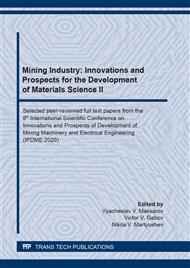[1]
A.E. Efimov, D.Y. Timofeev, V.V. Maksarov, Modeling dynamic processes at stage of formation of parts previously subjected to high-energy laser effects, IOP Conf. Ser.: Materials Science and Engineering 327(2) (2018) 022026.
DOI: 10.1088/1757-899x/327/2/022026
Google Scholar
[2]
A.P. Gospodarikov, Y.N. Vykhodtsev, M.A. Zatsepin, Mathematical modeling of seismic explosion waves impact on rock mass with a working, J.of Mining Institute 226 (2017) 405-411.
Google Scholar
[3]
V.V. Gabov, D.A. Zadkov, Mathematical model of simple spalling formation during coal cutting with extracting machine, J. of Physics: Conference Series 1015(52007) (2018) 1-6.
DOI: 10.1088/1742-6596/1015/5/052007
Google Scholar
[4]
M. Afonkin, E. Larionova, S. Gornyi, Analysis of laser engraving complexes technological Capabilities, Photonics 5 (2010) 4-11.
Google Scholar
[5]
E.I. Pryakhin, O.Y. Ganzulenko, A.P. Petkova, Development of polygraphic program-controlled hardware system for applying high-density coding on surface of products made from varied materials, IOP Conf. Ser.: Earth and Environmental Science 194(4) (2018) 042020.
DOI: 10.1088/1755-1315/194/4/042020
Google Scholar
[6]
O.Y. Ganzulenko, A.P. Petkova, Selection of alloying elements in steels for obtaining images full range of colors on the surface of the products by means of a pulsed laser radigation, J. of Mining Institute 209 (2014) 216-219.
Google Scholar
[7]
A.A. Orlov, A.V. Astafjev, System analysis of labeling methods for industrial products, Algorit my, Metody i Sistemy Obrabotki Dannyh 15 (2010) 136-140.
Google Scholar
[8]
V.I. Bolobov, V.S. Bochkov, I.I. Mishin, A.A. Nestruev, Influence of thermomechanical treatment on the wear resistance of materials of wearing elements of ore dressing equipment, Gornyy informatsionno-analiticheskiy byulleten' 1 (2017) 52-59.
Google Scholar
[9]
V.I. Bolobov, S.A. Chupin, V.S. Bochkov, About increasing wear resistance of rock-breaking tool to abrasion by using mechanical and thermo-mechanical treatmentInternational, Review of Mechanical Engineering 11(5) (2017) 301-304.
DOI: 10.15866/ireme.v11i5.11581
Google Scholar
[10]
E.I. Pryakhin, D.M. Sharapova, Modeling simulation of structure in a heat-affec ted zone of welded joint from low-alloyed steels, J. of Mining Institute 209 (2014) 239-242.
Google Scholar
[11]
A.I. Ziza, M.S. Mikhailov, V.V. Tsukanov, D.I. Nikolaev, T.A. Lychagina, A study of retained austenite transformation during high-strength Cr-Ni-Mo-V steel tempering, Letters on Materials, , 8(2) (2018) 146-151.
DOI: 10.22226/2410-3535-2018-2-146-151
Google Scholar
[12]
A.M. Shchipachev, S.V. Gorbachev, Influence of post-welding processing on continuous corrosion rate and microstructure of welded joints of steel 20 and 30KHGSA, J. of Mining Institute 231 (2018) 307-311.
Google Scholar
[13]
V.G. Milyuts, V.V. Tsukanov, E.I. Pryakhin, L.B. Nikitina, Development of manufacturing technology for high-strength hull steel reducing production cycle and providing high-quality sheets, J. of Mining Institute 239 (2019) 536-543.
DOI: 10.31897/pmi.2019.5.536
Google Scholar
[14]
V.V. Maksarov, A.I. Keksin, Technology of magnetic-abrasive finishing of geometrically-complex products, IOP Conf. Ser.: Materials Science and Engineering 327(4) (2018) 42068.
DOI: 10.1088/1757-899x/327/4/042068
Google Scholar
[15]
V.A. Krasnyy, The use of nanomaterials to improve the wear resistance of machine parts under fretting corrosion conditions, IOP Conf. Ser.: Materials Science and Engineering 560(1) (2019) 012186.
DOI: 10.1088/1757-899x/560/1/012186
Google Scholar


